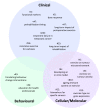Identification of Research Priorities in Exercise Oncology: A Consensus Study
- PMID: 32201540
- PMCID: PMC7066012
- DOI: 10.7150/jca.42992
Identification of Research Priorities in Exercise Oncology: A Consensus Study
Abstract
The growth of research in the field of exercise oncology has resulted in a large evidence base for the role of physical activity in preventing and managing cancer outcomes. Nonetheless, there remain many unanswered questions across the multidisciplinary field. This study aimed to determine the priority research questions within exercise oncology using a systematic consensus method. Forty-seven exercise oncology experts engaged in the five-step process of the Nominal Group Technique to generate a list of research questions in small groups and rank the 10 most important. One hundred questions resulted from the process and fifteen received total scores (sum of ranks) of at least 50 from a maximum score of 470. The highest ranked question (score of 125) related to the identification of functional markers of recovery. The next five questions concerned minimum exercise parameters, health professional education, translation of behavioural interventions, effects of exercise on the tumour microenvironment and development of in vitro models to study the impact of exercise on cancer cell growth and metastasis. The study has demonstrated the importance of future research across all disciplinary areas of exercise oncology and identified the priority questions to which resources might be directed.
Keywords: cancer; consensus; evidence; physical activity.
© The author(s).
Conflict of interest statement
Competing Interests: The authors have declared that no competing interest exists.
Figures

Similar articles
-
Moving Forward Through Consensus: A Modified Delphi Approach to Determine the Top Research Priorities in Orthopaedic Oncology.Clin Orthop Relat Res. 2017 Dec;475(12):3044-3055. doi: 10.1007/s11999-017-5482-7. Epub 2017 Aug 30. Clin Orthop Relat Res. 2017. PMID: 28856514 Free PMC article.
-
Consensus on priorities in maternal education: results of Delphi and nominal group technique approaches.BMC Pregnancy Childbirth. 2019 Jul 24;19(1):264. doi: 10.1186/s12884-019-2382-8. BMC Pregnancy Childbirth. 2019. PMID: 31340770 Free PMC article.
-
Priority setting in paediatric preventive care research.Arch Dis Child. 2017 Aug;102(8):748-753. doi: 10.1136/archdischild-2016-312284. Epub 2017 Apr 12. Arch Dis Child. 2017. PMID: 28404552
-
Consensus research priorities for paediatric status epilepticus: A Delphi study of health consumers, researchers and clinicians.Seizure. 2018 Mar;56:104-109. doi: 10.1016/j.seizure.2018.01.025. Epub 2018 Feb 5. Seizure. 2018. PMID: 29471256
-
Recommendations from the international evidence-based guideline for the assessment and management of polycystic ovary syndrome.Fertil Steril. 2018 Aug;110(3):364-379. doi: 10.1016/j.fertnstert.2018.05.004. Epub 2018 Jul 19. Fertil Steril. 2018. PMID: 30033227 Free PMC article. Review.
Cited by
-
Qualitative research exploring the complexities of exercise promotion in prostate cancer survivorship.Int J Qual Stud Health Well-being. 2025 Dec;20(1):2517803. doi: 10.1080/17482631.2025.2517803. Epub 2025 Jun 12. Int J Qual Stud Health Well-being. 2025. PMID: 40503842 Free PMC article.
-
Evaluation of a city-wide physical activity pathway for people affected by cancer: the Active Everyday service.Support Care Cancer. 2023 Jan 9;31(2):101. doi: 10.1007/s00520-022-07560-y. Support Care Cancer. 2023. PMID: 36622460 Free PMC article.
-
Retention rates and reasons for non-retention in exercise oncology trials in the post-treatment phase-a systematic review.J Cancer Surviv. 2024 Apr 3. doi: 10.1007/s11764-024-01569-4. Online ahead of print. J Cancer Surviv. 2024. PMID: 38570403 Review.
References
-
- MacVicar MG, Winningham ML, Nickel JL. Effects of aerobic interval training on cancer patients' functional capacity. Nurs Res. 1989;38(6):348–51. - PubMed
-
- Winningham ML, MacVicar MG, Bondoc M, Anderson JI, Minton JP. Effect of aerobic exercise on body weight and composition in patients with breast cancer on adjuvant chemotherapy. Oncol Nurs Forum. 1989;16(5):683–9. - PubMed
LinkOut - more resources
Full Text Sources

